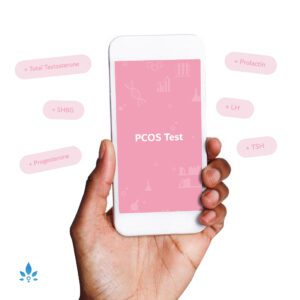Problems With Traditional Diagnosis of PCOS


Polycystic Ovary Syndrome (PCOS) is one of the most common causes of infertility in women of reproductive age. It affects between 4 and 10% of women globally; however, despite this high incidence, the complexity of the condition and the lack of understanding regarding its predominant symptoms, means that the time to diagnosis can be significantly delayed. This leaves some women waiting up to two years to receive positive confirmation that they have the condition.
PCOS is routinely diagnosed according to the Rotterdam criteria, which state that two out of three of the following symptoms are required for a positive diagnosis:
- Oligo/anovulation
- Polycystic ovaries
- Clinical or biochemical hyperandrogenism.
Unfortunately, it is often diagnosed by a process of elimination, whereby conditions with similar symptoms are discounted first of all. Which adds to the delay between initial identification of a problem and obtaining a positive diagnosis.
Oligo/anovulation
PCOS is the primary cause of anovulation in women of reproductive age. Anovulation occurs when the ovary does not release an oocyte (egg) during the menstrual cycle. Most women will have the occasional anovulatory cycle, without any underlying issue. However, 70-80% of women with PCOS will have fertility issues, usually due to persistent oligo- or anovulation.
If your periods are irregular, anovulation might be one of the first things your doctor considers. However, some women continue to have regular periods and in these cases diagnosing a cycle as anovulatory can be more of a challenge. The only way to clinically diagnose anovulation is to measure serum progesterone levels. Immediately after ovulation, progesterone levels rise markedly. If levels do not increase, the cycle is assumed to be anovulatory. Measurements should be taken over a number of cycles to ascertain whether ovulation is occurring regularly or not.
Fertility issues in isolation are insufficient grounds on which to diagnose PCOS; other symptoms also need to be present.
Polycystic ovaries
20-30% of the female population have ovarian cysts. They are very common and usually harmless. Polycystic ovaries will usually be diagnosed using pelvic ultrasound scans. Highest quality data is obtained using transvaginal scans, however, not all women will be comfortable with this, so scans can be performed via abdominal ultrasound. Discovering that you have polycystic ovaries does not mean that you have PCOS. However, if you have 12 or more follicles in each ovary measuring 2–9 mm in diameter, and/or an increased ovarian volume (10 mL or more), PCOS might be considered and your doctor may wish to test you against the other diagnostic criteria.
Hyperandrogenism
The main manifestations of clinical hyperandrogenism are hirsutism, acne and alopecia. Hirsutism is thought to affect between 65 and 75% of patients with PCOS; acne affects 12-14% and alopecia affects about 10%. However, the prevalence of each of these can vary with ethnicity; and acne, in particular, is fairly common in the general population, especially around puberty due to hormonal fluctuations.
A woman with biochemical hyperandrogenism has elevated levels of the male sex hormones. Testosterone, androstenedione and dehydroepiandrosterone (DHEA) / dehydroepiandrosterone sulphate (DHEAS) are the different hormones that might be checked using blood tests. However, some of the assays are limited by poor accuracy and sensitivity, particularly if designed to normally measure higher male levels.
Approximately 70% of women with PCOS have elevated levels of free testosterone. This is the fraction of the hormone that exerts an effect on the target tissue. Total testosterone includes the fraction of the hormone which is bound to sex hormone binding globulin (SHBG) in the serum. The problem with measuring serum levels of bound testosterone is that this does not necessarily correlate with the hormone’s biological activity and, thus, free testosterone is considered to be the more sensitive measure.
DHEAS was traditionally used as the clinical marker of androgen excess. It is abundant, stable and easy to measure. 25-35% of women with PCOS will have elevated DHEAS. Whether there is added benefit in measuring DHEAS and free testosterone together remains to be addressed, but there is some clinical evidence that women who have hyperandrogenism because of high DHEAS have more favourable metabolic outcomes than women with high testosterone.
Why does diagnosis take so long?
Unfortunately it can take time to establish the presence of these predominant PCOS symptoms. In fact, for many women, a problem is only identified when they struggle to conceive, despite actively trying for a period of time. Discerning the root cause of any suspected infertility is far from straight forward and requires comprehensive testing of both partners in a relationship.
Menstrual irregularities would certainly suggest that the female has an underlying issue of some sort, but even then doctors will usually test for other conditions, such as thyroid disorders and hyperprolactinaemia, first. Furthermore, as described above, anovulatory cycles in isolation are insufficient grounds on which to base a diagnosis of PCOS.
Identifying either of the other driving symptoms may take time. Cystic ovaries are, in general, asymptomatic; and if physical signs of hyperandrogenism are absent, a female may have biochemically elevated androgen levels, without knowing about it.
As with menstrual disturbances, in cases of hyperandrogenism, other conditions will usually be tested for first. These might include congenital adrenal hyperplasias and androgen-secreting tumours. Clearly, conditions that are potentially life-threatening need to be discounted early on in the diagnosis process, but this might mean a further delay in reaching a positive PCOS diagnosis.
Cushing’s syndrome is rare, but the symptoms of that disorder are similar to those seen in women with PCOS; for example, menstrual irregularities, hirsutism and acne. Therefore, the disorder is often screened for, even when PCOS is strongly suspected.
How could diagnosis be improved?
Diagnosing via a process of elimination is far from ideal. However, there are currently few ways in which to expedite the diagnosis of PCOS.
70-80% of women with PCOS will be insulin resistant, but with no accurate methods for measuring this, it does not currently form part of the diagnostic criteria. Some doctors may choose to screen for other metabolic conditions, or offer an oral glucose tolerance test, but this is usually done once a PCOS diagnosis has been made. Perhaps accurate assessment of insulin levels is an area that does warrant further research; as it is thought that an imbalance in both this hormone and testosterone are what underpins many features of the disease
Genetic testing is another tool that might be implemented for PCOS diagnosis in the future. Some genes are certainly thought to have a role in the aetiology of the condition. However, to date, there has been substantial difficulty in identifying which ones are directly involved in causing or predisposing women to PCOS. The condition is most likely multifactorial and polygenic in nature, meaning that a combination of genetic and environmental factors are responsible, and multiple genes may be involved.
Nabta Health hopes to change the way in which PCOS is diagnosed. By enabling women to manage their own health, it is hoped that the process of diagnosis can be streamlined, optimised and the average time frame of two years drastically reduced.
Nabta is reshaping women’s healthcare. We support women with their personal health journeys, from everyday wellbeing to the uniquely female experiences of fertility, pregnancy, and menopause.
Get in touch if you have any questions about this article or any aspect of women’s health. We’re here for you.
Sources:
- Azziz, Ricardo, et al. “The Androgen Excess and PCOS Society Criteria for the Polycystic Ovary Syndrome: the Complete Task Force Report.” Fertility and Sterility, vol. 91, no. 2, 2009, pp. 456–488., doi:10.1016/j.fertnstert.2008.06.035.
- Hamilton-Fairley, D. “Anovulation.” Bmj, vol. 327, no. 7414, June 2003, pp. 546–549., doi:10.1136/bmj.327.7414.546.
- Leo, V. De, et al. “Genetic, Hormonal and Metabolic Aspects of PCOS: an Update.” Reproductive Biology and Endocrinology, vol. 14, no. 1, 2016, doi:10.1186/s12958-016-0173-x.
- Lerchbaum, Elisabeth, et al. “Hyperandrogenemia in Polycystic Ovary Syndrome: Exploration of the Role of Free Testosterone and Androstenedione in Metabolic Phenotype.” PLoS ONE, vol. 9, no. 10, 13 Oct. 2014, doi:10.1371/journal.pone.0108263.
- “Long-Term Consequences of Polycystic Ovary Syndrome.” Royal College of Obstetricians and Gynaecologists, Nov. 2014, www.rcog.org.uk/globalassets/documents/guidelines/gtg_33.pdf.
- “Revised 2003 Consensus on Diagnostic Criteria and Long-Term Health Risks Related to Polycystic Ovary Syndrome.” Fertility and Sterility, vol. 81, no. 1, 2004, pp. 19–25., doi:10.1016/j.fertnstert.2003.10.004.
- Teede, H, et al. “Polycystic Ovary Syndrome: a Complex Condition with Psychological, Reproductive and Metabolic Manifestations That Impacts on Health across the Lifespan.” BMC Medicine, vol. 8, no. 1, 2010, doi:10.1186/1741-7015-8-41.













































